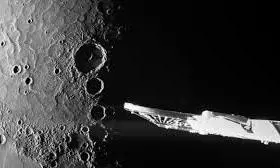
ESA spacecraft captures images of Mercury’s surface during flyby
text_fieldsThe European Space Agency's (ESA) BepiColombo spacecraft has captured stunning images of Mercury during its sixth and final flyby before settling into orbit around the planet in 2026.
Built by Airbus (formerly Astrium) and launched in 2018, BepiColombo flew just a few hundred kilometers above Mercury's north pole, revealing intricate details of the planet's surface, including icy craters and sunlit northern plains.
According to ESA, the images taken by BepiColombo's monitoring camera (M-CAM 1) show craters such as Prokofiev, Kandinsky, Tolkien, and Gordimer, whose permanently shadowed floors could potentially harbor frozen water. Despite Mercury's proximity to the Sun, these shadowed areas are some of the coldest places in the Solar System.
"Existing evidence suggests that these dark craters may contain frozen water," the ESA said. The spacecraft will further investigate the presence of water once it enters Mercury's orbit.
ESA Director General Josef Aschbacher unveiled the images during a press briefing, highlighting the value of the flyby data in understanding the Solar System's least-explored planet. Frank Budnik, BepiColombo’s flight dynamics manager, emphasized that these flybys provide critical insights ahead of the spacecraft’s primary mission phase in 2026.
In 2027, BepiColombo's Mercury Transfer Module will deploy two scientific payloads: ESA’s Mercury Planetary Orbiter and the Japan Aerospace Exploration Agency's (JAXA) Mercury Magnetospheric Orbiter. These orbiters will collect data from varying altitudes and orientations to unravel more mysteries about the planet.
Mercury, the smallest planet in the Solar System, orbits close to the Sun at an average distance of 58 million kilometers. It poses unique scientific puzzles, such as why its thin rocky crust overlays an oversized iron core, which constitutes 60% of its mass.
"BepiColombo’s main mission is to uncover Mercury’s enigmatic characteristics," said Geraint Jones, the project scientist.























